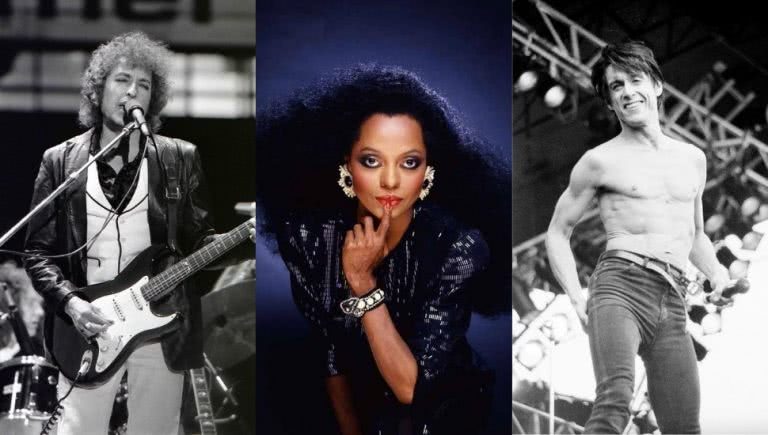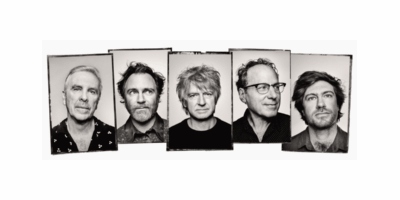The 1980s are generally regarded as a tough time for rock and pop music’s old guard. Artists who came to light in the 1960s were going through middle age, and the influx of neon colours, synthesisers, gender ambiguity and buckets of hair product threw many off course.
But there were also a number of excellent records made by established artists in the 1980s, and not just because they clung onto some concept of stylistic purity. Rather, the most interesting work came from artists who took the ’80s in their stride – those who updated their wardrobe, said hello to gated reverb, and against the odds, screamed “take a look at me now!”
The idea of timelessness is a bit misguided where music production is concerned. Pretty much everything is marked by the prevailing technologies of the era in which it was produced. And we think this should be celebrated, so long as the songwriting and performances don’t inhabit the cringe zone.
So here’s a look back on ten artists from the ’60s and ’70s who were able to adapt to the ’80s – with style.
1. ‘License to Kill’ by Bob Dylan:
Bob Dylan’s ’80s releases were used as a punchline for many years, perhaps because he made no attempt to evade the decade’s preference for slick, reverb-stained sounds. These are stamped all over Dylan’s 1983 record Infidels, the title of which referred to his return to “secular music” after three records dominated by evangelical themes.
Dylan hired Dire Straits’ Mark Knopfler to help him make the transition. And as awkward as this all might sound on paper, the record is a triumph. Bands like The War On Drugs and Vampire Weekend owe a clear stylistic debt to ’80s Dylan, and music historians have even started to change their tune on the strength of Infidels.

Love Music?
Get your daily dose of metal, rock, indie, pop, and everything else in between.
2. ‘You Got It’ by Roy Orbison:
Roy Orbison was 52 years old when he recorded ‘You Got It’ in 1988. It was to appear on the Big O’s first record in ten years, Mystery Girl. But while the record came out as planned in January 1989, Orbison had passed away one month earlier. Despite this tragedy, songs such as ‘You Got It’ don’t warrant attention simply because they’re the last recorded statements of a great artist. To the contrary, ‘You Got It’ is some of Orbison’s best work.
Orbison co-wrote the song with his Traveling Wilburys band mates Tom Petty and ELO’s Jeff Lynne, with Lynne handling the production. It retains the wall of sound feel of Orbison’s 1960s classics, while also benefitting from Lynne’s spacious production.

3. ‘Missing You’ by Diana Ross:
Some artists seem to have been waiting for the ’80s to start throughout their entire careers, and perhaps no one more so than Diana Ross. Ross finished her time with the Supremes in 1970s, but it would be another ten years before she made her defining work as a solo artist.
First, there was the 1980 album Diana, which featured the production and songwriting smarts of Nile Rodgers and Bernard Edwards (and included the likes of ‘Upside Down’ and ‘I’m Coming Out’). Four years later, Ross produced another of her career’s finest moments in the form of ‘Missing You’. Lionel Richie wrote and produced the forlorn power ballad, which appears on 1984’s Swept Away.

4. ‘Walking On Thin Ice’ by Yoko Ono:
The mythology surrounding ‘Walking On Thin Ice’ can sometimes distract from how great the song is. See, John Lennon’s guitar parts are said to be the last sounds he ever recorded. He was also apparently holding the master recording of ‘Walking On Thin Ice’ when he was shot on December 8, 1980.
But it’s a Yoko Ono song, and when it was released one month later, it became Yoko’s first solo chart hit. Yoko was always a step ahead of the pack and she brings an experimental flair to the post-disco sound of ‘Walking On Thin Ice’, infusing it with philosophical lyrics and iridescent pop hooks.

5. ‘Temporary Secretary’ by Paul McCartney:
Aside from Linda McCartney’s backing vocals, Paul McCartney’s 1980 release McCartney II is a solo affair. And like its nominal predecessor, 1970’s McCartney, the record was recorded in Paul’s home studio. This set-up suits McCartney as it allows him to let his freak flag fly.
Yes, McCartney has it in him to seem like an embarrassing dad – no one wants the likes of ‘Maxwell’s Silver Hammer’ or ‘Wonderful Christmastime’ storming in on their high school slumber party. But on McCartney II, he sounds like the sort of dad you’d want to get high with and fiddle around with synthesisers. It’s a brilliant record, front to back, but its most stimulating moment is ‘Temporary Secretary’, a truly eccentric take on synth-pop.

6. ‘Dweller on the Threshold’ by Van Morrison:
Van Morrison and the 1980s do not sound like a match made in heaven. And they weren’t – a notoriously cranky guy like Van wasn’t about to strap on a headband and get busy on the latest Roland synthesiser. But the decade did mark a stylistic departure for the Belfast musician, who left behind his R&B and folk rock roots to embrace elements of jazz and Celtic folk.
‘Dweller on the Threshold’ is a primary example of Morrison bringing the former influence to bear. Along with the inclusion of saxophone and trumpet, the song features a driving drum beat, which gave a contemporary feel and means it continues to slot in nicely in a feel-good DJ set.

7. ‘Fiction’ by Joni Mitchell:
Yep, even Joni Mitchel had a stab at making at ’80s studio pop. Throughout the decade, Mitchell largely set aside her folk and jazz influences to work alongside producer Larry Klein. Mitchell and Klein married in 1982 and their first album as husband and wife was 1985’s Dog Eat Dog.
The record’s standout track, ‘Fiction’, shows how the incorporation of big drum sounds, shimmering electric guitars and various electronic elements did not to temper the gravity of Mitchell’s songwriting.

8. ‘First We Take Manhattan’ by Leonard Cohen:
Something that’s not often acknowledged in retrospectives of the 1960s folk boom is that the movement’s great artists weren’t destined make music with acoustic guitars – it was in fashion. And so Leonard Cohen’s decision to go all-out Miami Vice on 1988’s I’m Your Man is perfectly natural – he was always interested in what was en vogue.
That it’s Cohen’s best album isn’t down to the heavy use of synthesisers and drum machines, but they’re an inescapable component of the record’s brilliance. So too are the vocals of Jennifer Warnes, Jude Johstone and Anjani, who often take on the role of co-lead vocalist rather than backing singer. That’s definitely the case with ‘First We Take Manhattan’, which features Anjani going toe to toe with Cohen’s wonderfully grizzled baritone.

9. ‘I Knew You Were Waiting (For Me)’ by Aretha Franklin and George Michael:
Aretha could do it all. Soul, R&B, doo wop, gospel – she’d already conquered all of these genres by the time the 1980s rolled around. So it should be no surprise that she’d be a dab hand at ’80s pop as well. She appears on two of the decade’s finest – albeit unlikely – duets. First, in 1985, she teamed up with Eurythmics’ Annie Lennox and Dave Stewart on the feminist anthem ‘Sisters Are Doin’ It For Themselves’.
Then, in 1987, Aretha united with George Michael on the euphoric pop song ‘I Knew You Were Waiting (For Me)’. Michael hadn’t yet released a solo album by this point, but the duet with Aretha proved he could hold his own with the greats. Reflecting on the song after Michael’s death in 2017, Franklin said, “musically, it does not grow old.”

10. ‘Shades’ by Iggy Pop:
‘Shades’ features on Iggy Pop’s 1986 album Blah Blah Blah, which was a collaboration with David Bowie. The record includes ‘Real Wild Child (Wild One)’, the success of which helped Blah Blah Blah become Pop’s crowning commercial achievement. But ‘Shades’ is the real gem here. It’s a booming ’80s pop song that raises a sentimental toast to Iggy’s favourite pair of sunglasses. That might sound a bit daft, but it’ll bring a tear to your eye.



































